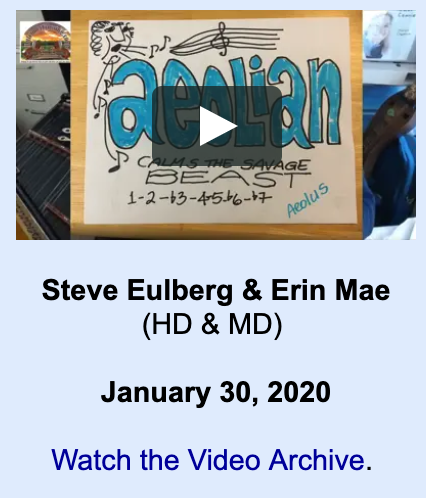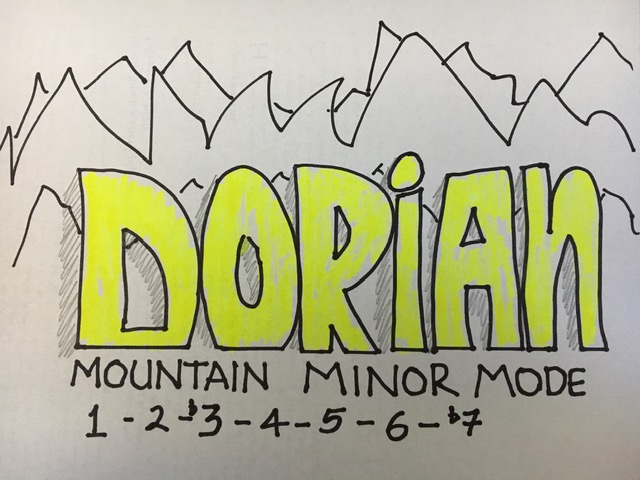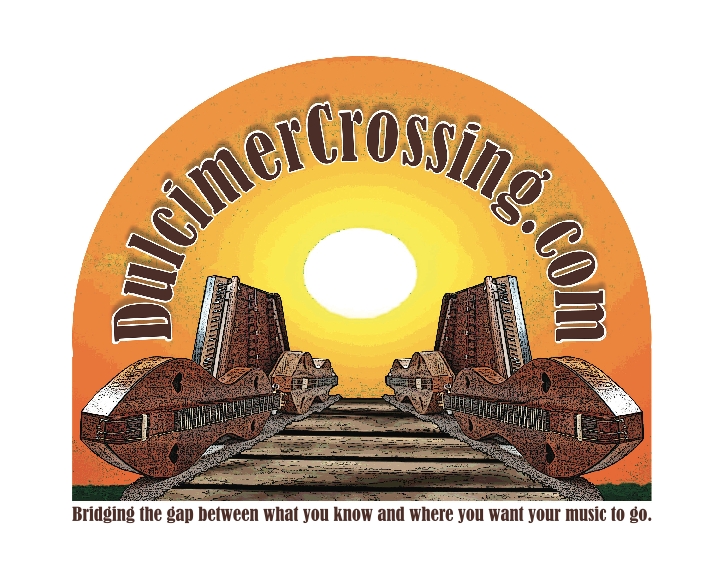
for Hammered Dulcimer
by Steve Eulberg
This was original published by DulcimerSessions.com, hosted by Mel Bay, which has ceased to host this webzine. [Download this article here]
If you’ve never heard of the Colorado Dutch Hop dance, dulcimer, or style of
playing, you are not alone. I played hammered dulcimer for 13 years before moving
to northern Colorado and learning of this pocket of musical tradition.
HISTORY
In 1763, Catherine the Great invited Europeans to populate an area along the Volga
River in Western Russia. Many Germans, weary from the Seven Years’ War, took
up that invitation. These people, now known as the Volga Deutsch, were amenable
to moving because of their social context: their land taxes were high and their sons
were constantly conscripted into the ruling families’ armies. Catherine sweetened the
pot by promising free transportation, free land, no land taxes for 30 years, and no
conscription for their young men! Many families gladly emgirated, taking with them
their beloved possessions, including the hackbrett or hammered dulcimer. However,
they insisted on speaking German or Deutsch and continuing with their time-honored
traditions.
In so doing, these emigrants preserved an instrument that in Europe was beginning to
undergo some radical changes that would eventually transform it from the keyed
dulcimers of Panteleon and Christofiori to what we recognize today as the pianoforte.
After some time, subsequent rulers in Russia began to covet the land upon which the
Volga Deutsch lived, and also longed to draft their sons into military service. Many
families again began the emigration process and moved to the middle of the USA,
eventually populating several rural areas from North Dakota south to Kansas, and the
eastern plains of Colorado. This migration took place at the beginning of the 20th
century.
Typical Volga Band, 1903.
This photo was taken in Ellis, Kansas.
From Mark Warren and Marilyn Hehr Fletcher, Hochzeit:
DUTCH HOPS: Colorado Music of the Germans from Russia, 1865-1965
Hochzeit (lit. “high times”) or WEDDING TRADITIONS
Once again they brought with them their traditions and beloved dulcimer. While it
was not used in the worship service celebrating the marriage, or the “blowing”
procession from the church to the house where the reception was held (which
featured wind instruments), I’m told that some people felt like they could not be
properly married unless the dulcimer was present at the wedding reception! Rooms in
the house of the bride (or groom) were emptied of furniture and rugs, and the dancing
commenced, accompanied by a band in which the dulcimer was the centerpiece.
People would dance for days (sometimes a week!) and pin dollars on both the bride
and groom as gifts to start them in their new life together.
Bennie Keller of the Polka Kings
The dulcimer often played lead and chordal runs and fills, together with violins,
clarinets, violas, cellos, trombones and other instruments. Many instruments came
and went. The accordion began to be a large part of the band in the 1940’s and yet
the dulcimer still remains—the only instrument to be continuously a part of the band!
The old-time players agree, however, that the accordion now seems to play lead and
the dulcimer has been moved to the background playing mostly chordal runs and fills.
Ben Wiedeman in the Wiedeman Dutch Hop band, 1947
The HOP
The “Germans-from-Russia,” as the Volga Deutsch were also known, have a unique
twist on the music that I learned to love as a youth in Ohio. When they dance there is
a hop in the step which I can recognize, but have not learned to duplicate. This is not
like the Polish hops which are an important part of the Polish Polka, and many
Deutschers in Colorado say that unless you learn as a young person to dance the
step, you’ll probably not learn it at all—correctly! Kurt Goldenstein, an heir to this
tradition, has interviewed many family members and studied both the music and
dance. He notes that it is easy for people of all ages to perform, and can be done in a
small, enclosed setting typical of wedding dances. (Goldenstein, Colorado Dutch
Hop Music arranged for Accordion).
“DUTCH HOP”
No one can point to a particular time when the dance and tradition of Dutch Hop
was named, but a bit of historical reminder can point the way.
During World Wars I and II the speaking of the German language in the USA led to
much persecution of German immigrants, including but not limited to the burning of
German churches throughout the plains states. I have met many people who
remember their parents sitting guard through the night with shotguns to scare off the
so-called, but misguided, “patriots” who wanted to strike terror at anything German.
In this climate, the Volga Deutsch, who had often been mis-labeled by English
speakers as the Volga Dutch, continued to have their dances, but in the climate of
hostility named them Dutch Hop dances. (The Dutch, after all, were on the side of
the Allies!)
TECHNIQUE
One of my first hammered dulcimer students in Colorado is an heir to this tradition.
He received his first dulcimer from his grandfather, who was an active player in
several Dutch Hop bands. Brian remembers his grandpa promising the dulcimer to
any of the grandchildren who would learn to play it. “It was a monster/beast of an
instrument, too. Hea–vy!”
He learned from his grandpa that the player needs to have that “bounce and roll” and
also learned to hold his hammers lightly between his first two fingers, in the manner of
cymbalom and santyr players.
Dutch Hop hammer hold
Brian confesses that he never really learned to do it completely, since he can only get
one hand to play with the hammers in the Dutch Hop style, the other hand stubbornly
refusing to hold the hammer except between the thumb and first finger, in the more
common style in today’s dulcimer world.
regular hammer hold
Many players talk about the uniqueness of Dutch Hop Music as a repertoire of tunes
which they inherited and to which they have added. Others say that it differs from
other polka music because the tunes have “attitude”; they are bouncier, have a faster
tempo, more drive, a rhythm that is not the expected “om-pah,” and the
accompaniment emphasizes the off-beats. (Goldenstein, pp. 41-42)
THE TUNE: “Wooden Heart Polka”
The “Wooden Heart Polka” is a tune that I danced to in northern Ohio as a youth,
but when I played it in Colorado, listeners said it was also present in the Dutch Hop
tradition. Goldenstein doesn’t include it in his list of Dutch Hop Tunes. However,
Adolph Lesser and Paul Weingardt, accordion leaders of very popular Dutch Hop
bands in the mid-twentieth century, often mention how they played all the music they
needed to play in order to get the gigs they needed! Ed. note: This melody is that
of the traditional German folk song, “Muss I Denn.”
Listen to Steve Eulberg play “Wooden Heart Polka.”
In the demo of the tune (MP3) I play the tune through (3) three times: the first in the
lower octave, the 2nd time in the higher octave, and the 3rd time in the lower octave,
but with more notes. The bounce and roll is evident in the slashes on the notes in the
written version below. (This lets the HD player do what we ALL want to do when
we play—double and triple hits!)
RESOURCES
In Print:
Book/CD
Goldenstein, Kurt Edward. Colorado Dutch Hop Music arranged for the
Accordion: The Music, history, and culture of Colorado’s Germans from
Russia. Self-published, with a grant from the Colorado Council on the Arts, 2000.
Kurt is an heir to this tradition and an accomplished accordion player has collected a
most valuable resource full of tunes, stories, photos and recipes.
Warren, Mark and Fletcher, Marilyn Hehr. Hochzeit: Dutch Hops: Colorado
Music of the Germans from Russia 1865-1965. Introduction by Al Holman.
Self-published, 1990.
Recordings:
CD
See Goldenstein, above.
Cassette
“A Colorado Dutch Hop Sampler” Produced by T & M Sound and Productions,
Lakewood, CO (303)989-5377, 1988. Nine Colorado Dutch Hop Bands each
contributing 2 songs to this sampler, produced with support from Swallow Hill Music
Association in Denver, the National Endowment for the Arts and the Colorado
Council on the Arts.
LPs
Most bands produced their own vinyl records, and according to Adolph Lesser they
often sold each other’s recordings at the dances at which they played.
On the World Wide Web:
“General Volga Germans”
http://www.volgagermans.net/volgagermans/Volga%20German%20Music.htm
Interview with Adolph Lesser by Timothy Kloberdanz. Lesser is one of the most
famous of the 20th century Dutch Hop band leaders (an accordionist). Kloberdanz is
on the faculty of the University of North Dakota and has been a dedicated researcher
of the traditions of the Germans-from-Russia.
http://www.lib.ndsu.nodak.edu/grhc/history_culture/oral/samples/
lesserp1.html
“Wedding Customs”
http://www.volgagermans.net/volgagermans/
Volga%20German%20Wedding%20Customs.htm
Other Resources:
American Historical Society of Germans From Russia (AHSGR), Lincoln, NE
http://www.ahsgr.org
GRHS-Germans from Russia Heritage Society, 1008 E. Avenue, Bismark, NE
58501, (701)233-6167
The Denver Public Library—Western History and Geneaology, 10 W.
Fourteenth Avenue Pkwy, Denver, CO 80204-2731 (303)640-6299
The Fort Collins Public Library, Local History Room
Germans from Russia Colorado Study Project
Curator, Germans from Russia Collection, Colorado State Univeristy
Libraries, Ft. Collins, CO 80523-1019
About the Author
Dutch Hop music resembles what Steve Eulberg learned to dance to as a young
teenager in northern Ohio. He learned to polka, waltz and schottische for fun, and to
his delight discovered that because he knew the steps and liked to dance them, he
was finally popular with the girls —at least for the duration of the dance!
This February in cold Quebec, Steve met Burr Beard, the first hammered dulcimer he
ever heard in his college days. “It’s all because of you that I’ve been adventuring and
playing this instrument for 26 years,” Eulberg exclaimed. “Thank-you!”
Steve built his first two instruments from Hughes kits, and the hammered dulcimers he
now plays are a Dusty Strings D260B and a James Jones Travel Chromatic. In
addition to exploring and preserving the Colorado Dutch Hop traditions, he is also
exploring the Indian Santoor, when not buzzing on his Australian Didgeridoo.
Steve teaches from his private studio in Fort Collins, Colorado, where he lives with
his family. He is the Director of Music at the Lutheran Campus Ministry at Colorado
State University, where his spouse is the pastor. He has 3 times been a Winfield
(National Flatpicking Championshps) finalist in the hammered dulcimer, and is busy
teaching and performing on the festival circuit. “‘Twas in the Moon of Wintertime,”
his instrumental recording of minor mode tunes from the Christmas season, was
nominated in two categories on the first 2003 Grammy ballot. His music has been
featured on NPR’s “Open Stage” and used as “buttons” for the NPR broadcasts,
has been played on United Airline’s Inflight Audio, and is currently featured in the
soundtrack of PBS’s “RoadTrip Nation.”.
Steve also is the owner of Owl Mountain Music, Inc. through which he records,
produces and publishes music. He can be reached at http://www.owlmountainmusic.com.















